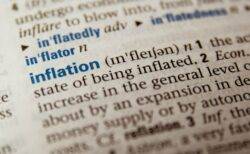Inflation has been creating problems around the world. (Credits: Getty Images)
Outside of reporting on the body politic, inflation news has often dominated the headlines of late.
Inflation has proved problematic worldwide in the wake of the Covid-19 pandemic, and particularly since Russia invaded Ukraine, and is a major driver in the cost of living crisis.
The term ‘inflation’ refers to a rise in prices, which is measured by the Office for National Statistics (ONS) in what’s called the Consumer Prices Index (CPI).
Every month, they put together a ‘basket’ of over 700 goods and services and compare their prices to where they were twelve months ago.
But how does the UK’s situation compare with other European economies?
Here’s what you need to know.
What is the inflation rate in the UK?
Recently, inflation in the UK has been hitting historical highs.
However, this month, the ONS announced that the Consumer Prices Index rose by 8.7% in the 12 months to April 2023.
This is down from 10.1% in March. However, food inflation in particular remains stubbornly high.
The Bank of England aims to keep inflation stable, usually by controlling interest rates (Picture: Guy Bell/Shutterstock)
The rate of inflation is back to single digits for the first time since last summer, predominantly due to gas and energy prices being more stable than they were in April of last year.
However, food and non-alcoholic beverage prices have continued to rise, with an eye-watering inflation rate of 19.1%, albeit slightly down on the previous month (19.2%).
Inflation in the UK appears to have peaked at 11.1% in October 2022.
What are the inflation rates across Europe?
Inflation rates across Europe vary, with some performing better than the UK, some performing worse, and others hovering around the same level.
According to Eurostat’s harmonised index of consumer prices (HICP), the inflation rate of the European Union (EU) for April 2023 was 8.1% (down from 8.3% in March 2023), meaning the UK’s 8.7% is still higher than the bloc’s average.
The EU countries performing worst are Hungary at 24.5%, Latvia at 15%, and Czechia at 14.3%, although all of those countries saw inflation decrease in the previous month.
Euro inflation for April 2023. (Picture: Eurostat)
However, at the bottom of the scale, Luxembourg sees the lowest inflation rate at just 2.7%, with Belguim’s 3.3% and Spain’s 3.8% just above.
Hovering around the UK’s current rate of 8.7% are Italy (at the same) and Croatia at 8.9%.
The wider Euro Area annual inflation rate was 7.0% in April 2023 – a 0.1% increase on the previous month – but still lower than the UK’s inflation rate.
The EU’s current average of 8.1% is down from its peak of 10.9% in September 2022, which was the highest the bloc has seen.
Previous peaks have included July 2008, when the economy saw inflationary pressures due to a sharp increase in the cost of oil, with inflation rates peaking at 4.4%.
Outside of Europe, other countries have also been struggling with inflation with the US also seeing 40 year high over the past year.
MORE : Food prices will be worse than energy bills in ‘new phase’ of cost of living crisis
MORE : One third of us plan to go abroad twice this year despite cost of living crisis
Follow Metro across our social channels, on Facebook, Twitter and Instagram
Share your views in the comments below
Inflation has reached record highs for lots of countries across the world.





